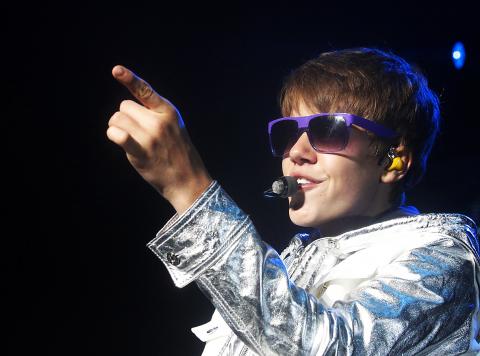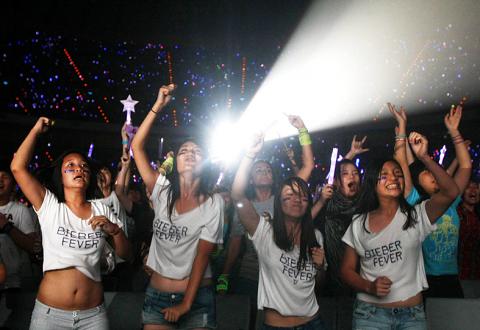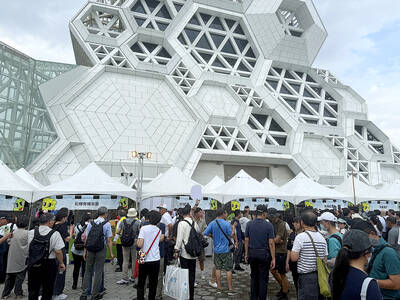He came, he sang, he gave them fever. Teenage pop star Justin Bieber performed at Taipei Arena (台北小巨蛋) on Sunday night for nearly 10,000 people in a show full of youthful pomp and pop theatrics.
A friend who teaches at middle school convinced me to go see Bieber — not for the music, but for the experience.
“It will be like the Beatles at Shea Stadium,” he said.

Photo by David Chen, Taipei Times, and Reuters
Sunday’s show wasn’t quite to the level of that historic concert — I spotted only a few young girls that were crying, and no one fainted as far as I know — but the enthusiasm was there.
The audience was made up of mostly teenage and adolescent girls, who let out deafening screams and squeals throughout Bieber’s 90-minute set.
And the fans weren’t the only ones with “Bieber Fever.” Shortly after taking to the stage one hour later than scheduled, the 17-year-old Canadian singer apologized for being late, saying that he was suffering from bronchitis. Organizers said that Bieber had been vomiting just before the show.

Photo by David Chen, Taipei Times, and Reuters
But if Bieber ever looked like he was suffering on stage, it wasn’t from his chest infection. He winced with heartache and longing as he wailed long soulful notes on his slower numbers.
Most of the time, though, Bieber was all teenage cool and full of bubblegum charm. He led a group of four dancers through tightly choreographed hip-hop dance routines, which included some kung-fu kicks and fake fighting on Bigger, one of the show’s opening numbers. Bieber had the entire audience singing along the infectious chorus to U Smile (“When you smile, I smile”).
It didn’t take much for Bieber to draw ecstatic cheers from the audience. High-pitched squeals and screams erupted at the beginning and end of each song, when he pulled a dance move, or even just moved to the side of the stage.
The crowd went particularly wild when Bieber introduced his song One Less Lonely Girl, and then serenaded a lucky female fan plucked from the audience.
Halfway through the set, Bieber took a short break for a costume change, and to keep the audience entertained, the crew broadcast a selection of YouTube videos on the big screen on the stage of Bieber performing as a child. The audience even screamed at beginning of each clip.
During the show, it was clear that Bieber looks up to Michael Jackson as a performer. He moonwalked, did the crotch grab and even sang Jackson’s Wanna Be Startin’ Somethin’.
Most of the 10,000 young girls and women in attendance at Sunday’s concert will disagree with me, but the show got boring pretty fast. It felt flat and lacking in momentum, as if Bieber and his backing performers couldn’t catch their spark, in spite of the high caliber production values, the costume changes, the tight backing band and the slick dance routines.
There’s no denying Bieber’s talent — he’s a good singer, and his best moments on Sunday were when he played solo, accompanied only by an acoustic guitar. Nor is there denying his charisma — his new documentary/concert film Never Say Never (2011) is worth watching for insight on his rise from YouTube star to pop star.
There was a minor kerfuffle after the show when a dozen or so angry parents gathered at the ticket gate, demanding a refund because the show had started so late.
But for most of the audience, Bieber could do no wrong. After the show, the arena was mostly empty and the lights were on, but a few groups of fans lingered as Bieber’s crew packed up the stage.
I saw two girls, who looked around 14 or 15 and wore matching Justin Bieber T-shirts, slowly shuffle towards the exit. A group at the other end of the hall started to scream.
One of the girls stopped, turned around, answered with a short, piercing squeal, and then immediately giggled as she left the hall, arm-in-arm with her friend.

Following the shock complete failure of all the recall votes against Chinese Nationalist Party (KMT) lawmakers on July 26, pan-blue supporters and the Chinese Communist Party (CCP) were giddy with victory. A notable exception was KMT Chairman Eric Chu (朱立倫), who knew better. At a press conference on July 29, he bowed deeply in gratitude to the voters and said the recalls were “not about which party won or lost, but were a great victory for the Taiwanese voters.” The entire recall process was a disaster for both the KMT and the Democratic Progressive Party (DPP). The only bright spot for

Water management is one of the most powerful forces shaping modern Taiwan’s landscapes and politics. Many of Taiwan’s township and county boundaries are defined by watersheds. The current course of the mighty Jhuoshuei River (濁水溪) was largely established by Japanese embankment building during the 1918-1923 period. Taoyuan is dotted with ponds constructed by settlers from China during the Qing period. Countless local civic actions have been driven by opposition to water projects. Last week something like 2,600mm of rain fell on southern Taiwan in seven days, peaking at over 2,800mm in Duona (多納) in Kaohsiung’s Maolin District (茂林), according to

Aug. 11 to Aug. 17 Those who never heard of architect Hsiu Tse-lan (修澤蘭) must have seen her work — on the reverse of the NT$100 bill is the Yangmingshan Zhongshan Hall (陽明山中山樓). Then-president Chiang Kai-shek (蔣介石) reportedly hand-picked her for the job and gave her just 13 months to complete it in time for the centennial of Republic of China founder Sun Yat-sen’s birth on Nov. 12, 1966. Another landmark project is Garden City (花園新城) in New Taipei City’s Sindian District (新店) — Taiwan’s first mountainside planned community, which Hsiu initiated in 1968. She was involved in every stage, from selecting

The latest edition of the Japan-Taiwan Fruit Festival took place in Kaohsiung on July 26 and 27. During the weekend, the dockside in front of the iconic Music Center was full of food stalls, and a stage welcomed performers. After the French-themed festival earlier in the summer, this is another example of Kaohsiung’s efforts to make the city more international. The event was originally initiated by the Japan-Taiwan Exchange Association in 2022. The goal was “to commemorate [the association’s] 50th anniversary and further strengthen the longstanding friendship between Japan and Taiwan,” says Kaohsiung Director-General of International Affairs Chang Yen-ching (張硯卿). “The first two editions